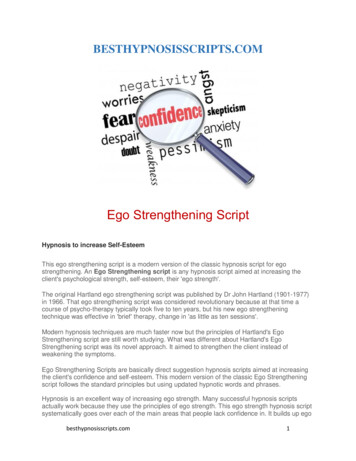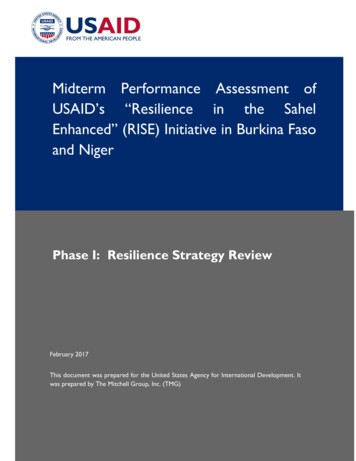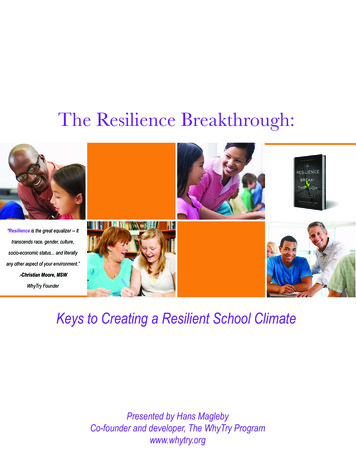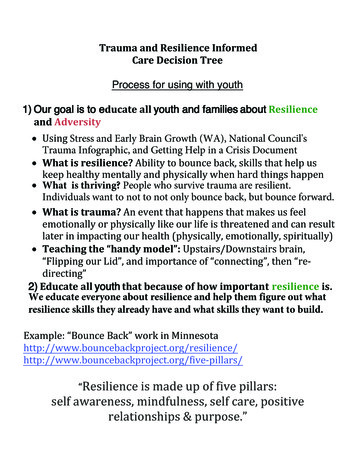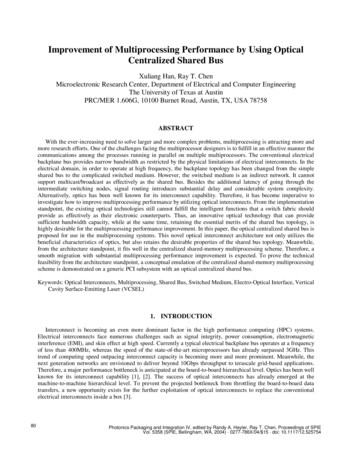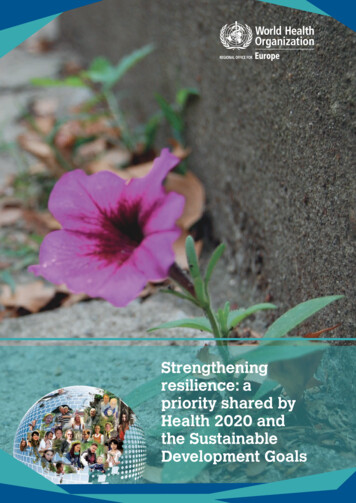
Transcription
Strengtheningresilience: apriority shared byHealth 2020 andthe SustainableDevelopment Goals
Strengtheningresilience: apriority shared byHealth 2020 andthe SustainableDevelopment Goals
AbstractResilience is at the core of the WHO European policy framework for health and wellbeing – Health 2020 – and the United Nations Sustainable Development Goals. Despiteresilience having become a buzz-word of late, its concept is often misunderstood.This publication illustrates the three levels of resilience (individual, community andsystem) and their implications for health. It also describes four capacities of resilience– absorptive, adaptive, anticipatory and transformative – which can be applied at allthree levels. The publication expands on the WHO publication, Building resilience: akey pillar of Health 2020 and the Sustainable Development Goals. Examples from theWHO small countries initiative.Keywords:RESILIENCE, PSYCHOLOGICALSOCIAL SUPPORTCOMMUNITY PARTICIPATIONGOALSCONSERVATION OF NATURAL RESOURCESHEALTH POLICYAddress requests about publications of the WHO Regional Office for Europe to:PublicationsWHO Regional Office for EuropeUN City, Marmorvej 51DK-2100 Copenhagen Ø, DenmarkAlternatively, complete an online request form for documentation, health information, or forpermission to quote or translate, on the Regional Office web site (http://www.euro.who.int/pubrequest). World Health Organization 2017All rights reserved. The Regional Office for Europe of the World Health Organizationwelcomes requests for permission to reproduce or translate its publications, in part orin full.The designations employed and the presentation of the material in this publication donot imply the expression of any opinion whatsoever on the part of the World HealthOrganization concerning the legal status of any country, territory, city or area or ofits authorities, or concerning the delimitation of its frontiers or boundaries. Dottedlines on maps represent approximate border lines for which there may not yet be fullagreement.The mention of specific companies or of certain manufacturers’ products does notimply that they are endorsed or recommended by the World Health Organization inpreference to others of a similar nature that are not mentioned. Errors and omissionsexcepted, the names of proprietary products are distinguished by initial capital letters.All reasonable precautions have been taken by the World Health Organization to verifythe information contained in this publication. However, the published material is beingdistributed without warranty of any kind, either express or implied. The responsibilityfor the interpretation and use of the material lies with the reader. In no event shallthe World Health Organization be liable for damages arising from its use. The viewsexpressed by authors, editors, or expert groups do not necessarily represent thedecisions or the stated policy of the World Health Organization.Edited by Nicole SatterleyBook design by Marta PasqualatoPrinted in Italy by AREAGRAPHICA SNC DI TREVISAN GIANCARLO & FIGLICover: Kelly AndersonThis publication was prepared by Erio Ziglio, Honorary Professor, University of AppliedSciences Tirol, Austria
CONTENTSAims of the publication.1Issues covered.21. What do we mean by resilience?.31.1 Resilience at individual and community levels. 41.2 System-level resilience. 51.3 Specifications when using the term resilience. 72. The role of resilience in Health 2020.73. The role of resilience in the SDGs.104. The role of health policy.125. The role of other sectors.15Conclusions .19References.20Annex 1 Types of resilience capacity.30Annex 2 Frequently asked questions about resilience.31iii
iv Simon Matzinger
Aims of the publicationNowadays, the concept of resilience is being used increasingly inacademia, among professional bodies, in business, by human rightsand civil society organizations and in a wide range of policy sectors.The concept may run the risk of over-exposure and being used asfashionable buzz word; the risk is that once the fashion passes, theconcept may be quickly abandoned. Strengthening individual-,community- and system-level resilience is far too important for effectivehealth interventions, and therefore such a risk must be avoided. In thehealth field, strengthening resilience is to form part of policies andprogrammes designed to promote an holistic and sustainable approachto individual and community health and well-being. To foster lastingand meaningful action to strengthen resilience to improve health andwell-being, it is vital to be clear about its particular significance. This iswhat this publication sets out to achieve.Since the endorsement of Health 2020 (1), the topic of resiliencehas been particularly present on the agenda of the meetings of theWHO small countries initiative (2–5). This publication builds andexpands on the discussions held, and outcomes achieved, at thosemeetings. In particular, it expands on a recent publication of the WHORegional Office for Europe, entitled Building resilience: a key pillarof Health 2020 and the Sustainable Development Goals. Examplesfrom the WHO small countries initiative (6). It aims to shed light onthe importance of strengthening individual-, community- and systemlevel resilience for population health and well-being outcomes. Thepublication maintains that strengthening resilience is crucial in orderto make progress towards the implementation of both the Health 2020targets and the Sustainable Development Goals (SDGs).The publication has three crucial aims: first, to provide a comprehensivereview of the literature showing the significance of resilience for healthand well-being outcomes; second, to ensure that strengtheningresilience and developing supportive environments are an integralpart of current and future processes to align national and subnationalhealth plans with the Health 2020 policy framework; and third, toemphasize that such processes should impact on resilience-buildingand fully exploit the many beneficial synergies between Health 2020and the SDG agenda.1
Issues covered Simon MatzingerThe rationale behind Health 2020’s priority area 4 – strengtheningresilience and a supportive environment for health and well-being – isoutlined and explored in section 2 of the publication, which includesa review of the relevance of resilience for population health and wellbeing. Different levels of resilience and types of resilience capacity,as currently portrayed in the scientific literature, are summarized inthe sections that follow. Strengthening resilience characterizes and isinvolved in some way in all the actions recommended to achieve theSDGs; thus, the way in which resilience is referred to in the SDGs is alsobriefly explored. Finally, the document concludes with two annexes.One contains answers to frequently asked questions about resilienceand the second describes the four major types of resilience capacitypresented in the current literature.2
1.What do we mean by resilience?Various definitions of resilience can be found in the scientific literature.Notwithstanding their differences, they all point to the fact thatresilience is related to processes and skills that result in good individualand community health outcomes, in spite of negative events, seriousthreats and hazards (7–10). More recently this definition has beenbroadened to include the desire and urgency to strengthen theresilience of social systems, including health (11,12).In the health field the concept of resilience was originally referred to interms of children and young people, but has since been broadened toincorporate adults and elderly people (13). Disciplines with a focus onchildren (such as developmental psychology) conducted many studiesand discovered that resilient young people possess the problemsolving skills, social competence and sense of purpose that enablethem to cope with stressful situations (10,14). Research has shown thatthese capabilities in children and adolescents help them to reboundfrom setbacks, thrive in the face of poor circumstances, avoid risk-takingbehaviour and generally continue to lead productive lives (10,15–17).Another discipline that played a strong role in the early studies onresilience and its impact on health and well-being was traumatology.Here, the focus was mainly on adulthood and old age (18). The resultsof these studies showed that adult response to stress is very muchinfluenced by the type of interaction individuals have with each otherand the settings in which they live. These factors are of meaningfulsignificance to victims of trauma. Adult response also dependson factors associated with the reliability of the resources availableto them. This relates not only to material resources, but also to thesupport available to them in the web of social networks on which theyrely (specifically victims of trauma). The latter may include cultural andreligious organizations, self-help groups and other community andsocietal assets (13, 18–22).It should also be noted that resilience has a very prominent role inessentially all of the SDGs (23), whereby it is positioned mainly atsystem level. System-level resilience originated in studies in the field ofecology and ecosystems (24). It has now expanded in many fields andpolicy sectors, as explored in more detail throughout the publication(see in particular subsection 1.2).3
1.1 Resilience at individual and community levelsThe American Psychological Association defines individual-levelresilience as the process of adapting well in the face of adversity, trauma,tragedy or threats. It also includes coping with significant stress causedby problematic and toxic relationships in the family or at the workplaceand the capacity to bounce back from difficult experiences (25). Similarly,community resilience is seen as the ability of social groups to withstandand recover from unfavourable circumstances. In the literature,community resilience is usually associated with social relationshipsand the activation of local resources that enable communities to copewith, counteract and anticipate unhealthy stressors (26,27).1 The lattermay include social and economic stressors such us poverty, naturaldisasters, isolation and other unfavourable circumstances. Communityassets such as level of solidarity and mutual trust among its members,quality of social networks and other salutogenic resources have provento be protective and promoting factors to health and well-being (28).As for individual and community resilience, there is now widespreadagreement that resilience is not a given personal or community,unmodifiable characteristic. Rather, it is the result of a developmentalprocess that can become stronger over time, according to circumstances(9). A number of resilience-related studies have looked into thecharacteristics of people and communities and the factors that allowthem to manage problems effectively and bounce back after adversity.They have shown that the capability of individuals and communitiesto cope successfully in the face of significant adversity develops andchanges over time (21,26,27).Health 2020 points out that building resilience is shaped by theavailability of supportive environments (1). This means that interventionsaiming to strengthen resilience are more effective when supportedby environments that promote and protect population health andwell-being (29). Supportive environments are essential for people toincrease control over the determinants of their health. Back in 1986the WHO definition of health promotion already referred to enablingpeople to increase control over and improve the determinants of theirhealth. Indeed, creating supportive environments is one of the five1 Another important information source on this subject is a publication on buildingresilience in health systems prepared by Professor Lino Briguglio and Dr NatashaAzzopardi-Muscat for the fourth high-level meeting of the WHO small countriesinitiative (held in Valletta, Malta, June 2017).4
action domains of the Ottawa Charter for Health Promotion (30). WHOthus has a strong legacy in terms of promoting the importance of bothsupportive environments and resilience to enable effective delivery ofhealth and well-being outcomes. This is firmly incorporated into Health2020’s priority area 4.The notion of being in control is intrinsically linked to individual-,community- and system-level resilience. For example, the level ofcontrol (or lack of it) that a person has over her/his life has been shownto be a key factor in the social determination of health and healthinequities (20,31,32). The concept of control has been identified as oneof the major factors in determining access to resources that protectand promote health. It can be traced back to Amartya Sen’s theory onthe freedom and the capabilities required for a long and healthy life(33). Sen shows that lack of control and powerlessness experienced byindividuals and communities are the fundamental causes of inequitiesin health observed in different population groups (33). These findingswere confirmed in the final report of the Global Commission on theSocial Determinants of Health (2008) (31) and in the European reviewof the social determinants of health and the health divide (2013) (32).1.2 System-level resilienceAs mentioned earlier, this level of resilience is very much prioritizedwithin the SDGs. In the literature, system resilience is defined as thecapacity of a system to absorb, adapt, anticipate and transform whenexposed to external threats – and/or to forecast shocks that bring aboutnew challenges and opportunities – and still retain control over itsremit and pursuit of its primary objectives and functions (24). Resilientsystems develop the capacity to absorb, anticipate or recover fromshocks, while adapting and transforming positively their structures andmeans of operating (34).In terms of system resilience, there has been much debate andrecommended action, particularly as result and lessons from theEbola virus disease outbreak in West Africa (35). Strengthening systemresilience is seen instrumental in order to: better tackle current andfuture patterns of ill health; create conditions for the protection andpromotion of health and the reduction of health inequities; andincrease preparedness in dealing with unexpected risks for populationhealth (36,37).5
Strengthening system resilience is particularly dependent on thecapacity of a given system to manage internal and external factors thathave an influence on its development (38). These factors include allthe elements that influence policy-making. The WHO Regional Officefor Europe published an interesting study of the ways in which healthsystems counteract shocks, such as the current economic crisis (that isstill hitting several countries at the time of writing). The analysis showsdifferent types of resilience capacity in absorbing and adapting to theimpact of the crisis and also in transforming practices to cope betterwith change and uncertainties (39).Within the SDGs, system resilience is not just a reactive capacity (e.g.the capacity to absorb and adapt to shocks such as a natural disaster,climate change, a sudden unexpected infectious disease pandemic,or a financial crisis). In order to achieve the SDGs, system resilienceought to also be a proactive capacity. The need for this capacity isadvocated by the United Nations General Assembly resolution thatadopted the SDGs. The declaration points out that in order to addressthe challenges of the years ahead, a new approach is needed, wherebyresilience-transforming capacity is key. In its 13th item, the declarationstates that “sustainable development recognizes that eradicatingpoverty in all its forms and dimensions, combating inequality within andamong countries, preserving the planet, creating sustained, inclusiveand sustainable economic growth and fostering social inclusion arelinked each other and are interdependent” (23:6). It is clear that toachieve such massive change, transformative resilience capacity has tobecome a fundamental characteristic of policy-making.Resilience-transforming capacity is also important in the health field. Itmay relate to the capacity of the system to transform some obsoletepractices, or to redesign the provision of some services and publichealth programmes, required as a result of demographic changes ormedical and technological breakthrough. Resilience at system levelcan be strengthened by the introduction of new financial mechanismsto increase the economic sustainability of the system to anticipateand counteract possible future crises (36). An increased role of healthpromotion and health literacy can be instrumental in strengtheningresilience for individuals and communities, resulting in better accessto services and enabling their more beneficial use. Here, resiliencetransforming capacity could foster financial incentives applicable to awide range of policies and supportive conditions for health and wellbeing (38–40).6
1.3 Specifications when using the term resilienceWhen the term resilience is used in the health field, three specificationsshould ideally always be made. First, there should be clarity about thenature of the risks or the causes of the vulnerabilities that resilienceis meant to address. Second, the level or context in which the termis used should be clearly specified (that is, individual-, community- orsystem-level resilience). Third, efforts should be made to clarify thetype of processes that are intended to be used to strengthen resilience;for example, evidence should be provided that such processes andmeasures do indeed impact on resilience, including how and atwhat level. Unwanted side-effects (if any) as a result of the measuresundertaken should also be highlighted. Needless to say that suchprocesses and measures can differ according to the level of resiliencethat is to be strengthened (individual, community or system).Thus, in order to be meaningful in operational terms, resilience shouldalways be specified in terms of:(i) the causes of the vulnerabilities that the strengthening of resilienceshould tackle;(ii) the context or level of application of the measures identified toimplement the strengthening of resilience; and(iii) the type of – and impact from – the measures and processesadvocated for to positively impact on resilience.7
2. The role of resilience in Health 2020Health 2020 is the WHO health policy framework developed to assistEuropean countries in their individual and collective pursuits ofhealth, equity and well-being. It was adopted by the WHO RegionalCommittee for Europe on 12 September 2012 during its 62nd sessionin Valletta, Malta. Its strategic objectives are twofold: to improve healthfor all, and to reduce health inequities through improved leadershipand governance for health. In addition, Health 2020 identifies fourcross-cutting priority areas for action, of which one specifically refersto resilience (1):(1) investing in health through a life-course approach and empoweringpeople;(2) tackling Europe’s major health challenges (noncommunicable andcommunicable diseases);(3) strengthening people-centred health systems, public health capacityand emergency preparedness, surveillance and response;(4) creating resilient communities and supportive environments (1).Of the four priority areas, perhaps the least understood or mostunderestimated is priority area 4.Health 2020 states that “building resilience is a key factor in protectingand promoting health and well-being at both the individual andcommunity levels” (1:131). It specifies that the development ofsupportive environments is instrumental in building resilience.According to Health 2020, collaboration among policy sectors andthe full engagement of civil society are crucial for the developmentof supportive environments and for strengthening resilience; this isencapsulated within the framework by the terms whole-of-governmentand whole-of-society, to describe the relevant approaches (1).Health 2020 priority area 4 is essential for modernizing and increasing theperformance of health services and public health programmes. Severalstudies have revealed that the impact of these programmes can behampered by overusing the deficit model, as it is known: an approachthat focuses solely on the deficits of individuals and communities (41).Deficits are measured in negative terms, usually estimated on the basisof mortality and morbidity data. Such an approach is very prominentin interventions that are based only on the assessment of what doesnot work in a given community. It grossly overlooks what actually works8
well and the potential health assets of the population (41). Resilience isone such important asset.It has been argued that people as well as social systems do notdevelop because of their deficits but rather on the strength of theirassets and resilience capacities (42). Asset-based approaches arerequired to complement the deficit model, with the emphasis being oncomplementing, rather than replacing (43). This is how strengtheningresilience and community health assets are conceptually embodiedin the Health 2020 policy framework (1).Health 2020 specifies that in order to flourish, individual andcommunity health requires resilience to be strengthened andsupportive environments developed. Supportive environments offerpeople protection from factors that can threaten their health, as well asenabling them to expand their capabilities and self-reliance (1,30,44–47). Such environments constitute the basic conditions necessary toensure health protection and promotion at individual and populationlevels, despite threats and hazards. The development of supportiveenvironments for population health and well-being can include bothsectoral and intersectional measures. Political action, focusing onimplementing pro-health policies and regulations can also be referredto as constituting supportive environments.Thus, supportive environments may include (for example) tobaccocontrol legislation, or bans on advertising unhealthy junk food tochildren. Such environments can result from the use of financialincentives (for example, to increase the availability and affordability ofhealthy food, or the adoption of safety measures at the workplace) ordisincentives (such as raising prices or limiting availability of unhealthyproducts). In addition, the provision of cultural, educational and localcommunity resources can shape a wide range of environments thatempower individuals to take control of their health and improve theirphysical and living environments (44). All these factors create conditionsfor resilience to flourish. In summary, Health 2020 recommends thataction aimed at strengthening resilience should go hand in hand withthe development of supportive environments.9
3. The role of resilience in the SDGsIn adopting resolution A/RES/70/1, Transforming our world: the 2030agenda for sustainable development on 25 September 2015, theUnited Nations General Assembly made its mark in history (23). TheSDGs call for global mobilization to tackle issues of widespread publicconcern. The elimination of poverty, hunger, climate change, disease,food insecurity, and environmental degradation, the strengthening ofpreparedness for man-made and natural disasters, and the sustainabilityof the planet’s ecosystems are some of the global challenges includedin the 2030 agenda and its 17 SDGs and 169 associated targets (23,48).The overall perspective of the 2030 Agenda is totally in harmony with theconceptual background and priority actions recommended in Health2020 (1,23). The SDGs have greatly increased the profile of resilience.Sustainable development requires sustainable societies, and resiliencecomprises a key element. It implies the search for – and deployment of– structural processes and scientifically robust solutions to address thevulnerability of the planet. All this requires resilience-building at variouslevels (49,50). SDG 1 envisages building the resilience of the poor andthose in vulnerable situations, as well as reducing their exposure andvulnerability to extreme climate-related events and other economic,social and environmental disasters. SDG 2 calls for sustainable foodproduction systems and the implementation of resilient agriculturalpractices. SDG 9 relates to industry and innovation and calls forbuilding resilient infrastructures. SDG 11 focuses on sustainable citiesand communities and advocates action to make cities and humansettlements inclusive, safe, resilient and sustainable. SDG 13 calls forstrengthening resilience and capacity for adapting to climate-relatedhazards and natural disasters in all countries. SDG 14 aims to strengthenthe resilience of marine and coastal ecosystems (23,49). Thus, the SDGscall for resilience mainly at the system level.The implementation of frameworks such as Health 2020 at the nationaland subnational levels of policy-making is crucial to achieving theSDGs (1,23). Strengthening resilience and developing environmentssupportive for population health and well-being are essential toachieving both the health-related SDGs and those pertaining to othersectors (23). Ensuring healthy lives and promoting well-being for all,at all ages, is the specific focus of SDG 3. In reality, building resilienceand environments supportive of population health and well-being10
is instrumental in achieving all of the SDGs (6,51). Resilience is notexplicitly mentioned in the wide-ranging SDG 3 (to ensure healthylives and promote well-being for all at all ages) or its 13 targets (23).Nevertheless, it is increasingly recognized that building communityresilience and supportive environments for health and well-being (asHealth 2020 priority area 4 strongly advocates (1)) is also indispensablein relation to SDG 3 (23). Population health can be regarded as aprecondition for, and an enabler as well as an outcome of, sustainabledevelopment. Simon MatzingerIn conclusion, resilience as advocated in the SDGs (23) requires resilientcitizens and communities. It also requires resilient systems to dealwith potential vulnerabilities, shocks and disturbances by developingabsorptive, anticipatory and adaptive capacities (34). Furthermore, theachievement of the SDGs also requires a proactive approach to resilience,usually referred to as transformative capacity. These capacities (outlinedin Annex 1) date back to the pioneering work of Holling, among others,in the 1970s, advocating the need to build resilience in communitiesand systems to preserve and improve ecosystems and pursue positivechange (6,24,51). Resilience is a key factor in the SDGs and a centralmechanism for making progress in addressing them (52–54).11
4. The role of health policyStrengthening resilience and developing supportive environments forpopulation health and well-being is part of effective practices in curative,rehabilitation, preventive and health-promotive action undertaken bythe health system and public health programmes. Building resilienceis key for effective prevention, rehabilitation and healing processesand in tackling health inequities (31–33). Much of the research intohow having a sense of control affects health and well-being has eitheroverlooked or underestimated the role of the health system and publichealth programmes in this domain (55). Indeed, effective public healthprogrammes can create conditions that help people avoid healthhazards and, in turn, builds personal and community capacity topromote health and well-being (56).High-performing health systems and effective public health policiesand practices can therefore enhance resilience at the three levels(individual, community and system or societal) (8). For example, inproviding appropriate health care and social support to patients witha noncommunicable disease (NCD), considerations should be givento the social and physical settings where they live. There are excellentexamples that show that health systems, through their stewardshipfunction, can work with other sectors (such as housing and socialservices) to increase the ability of patients to cope with their chronic anddegenerative conditions (57). Thus, helping patients with a debilitatingNCD – for example, by rearranging their home furniture and facilities,and/or providing an easy remote phone link with emergency healthservices – has proven to be effective for patients to maintain their selfimage, mental health and motivation (58,59).These practices, facilitated by health systems, increase patients’ senseof control. This strengthens their resilience and, thus, has positiveeffect on their health and well-being (60,61). Health promotion – asdefined by WHO as the process of enabling people to increase controlover and improve their health – is of particular importance here. Healthpromotion action is clearly linked to strengthening resilience (30).Health promotion (along with its link with resilience) not only embracesactions to strengthen individual skills and resilience capabilities,but also includes actions to change unhealthy social, environmentaland economic con
health and well-being outcomes. This is firmly incorporated into Health 2020’s priority area 4. The notion of being in control is intrinsically linked to individual-, community- and system-level resilience. For example

